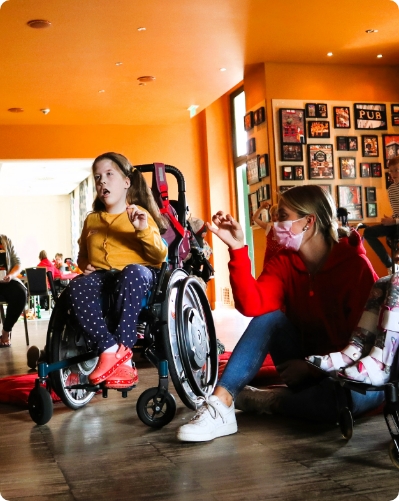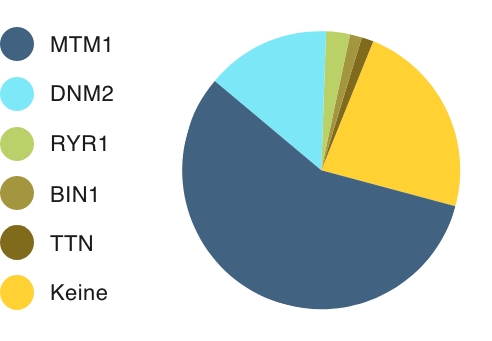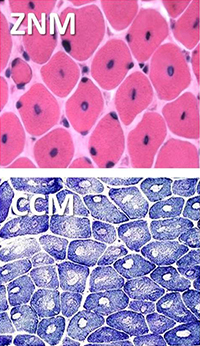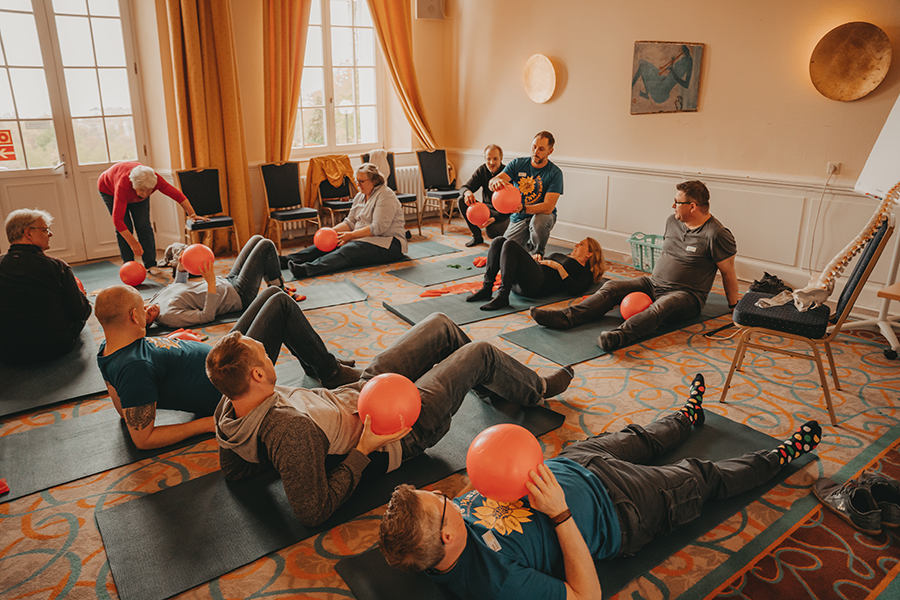Der Inhalt dieser Sektion kann innerhalb des Templates „main-menu-offcanvas“ eingestellt werden.
zu den Templates

Centronuclear myopathies are congenital (congenital = genetic) muscle diseases. A common feature of these diseases is that the nucleus of the muscle fibers is not located at the edge but in the center of the cell.
the x-linked recessive form localized in the MTM1 gene, also known as myotubular myopathy
the autosomal dominant form localized in the DNM2 gene
the autosomal recessive forms localized in the TTN, BIN1 or RYR1 gene
In addition, there are other, even rarer gene mutations that are also associated with centronuclear myopathy (MYF6, MTMr14, CCDC78). What all these diseases have in common is a generalized, usually non-progressive muscle weakness, whereby the severity also varies greatly within the individual clinical pictures.
The affected genes have a mutation. This mutation leads to a certain enzyme being produced incorrectly or not at all (e.g. in MTM1 – the protein myotubularin). The lack of the enzyme myotubularin then leads to defects in the structure of the muscle and thus to muscle weakness (e.g. myotubular myopathy).


That is difficult to answer. At the IGBMC, where Jocelyn Laporte and Johann Böhm work, around 700 patients were examined between 2000 and 2015. In most of them, mutations were found in the following genes: 400 in MTM1, 100 in DNM2, 20 in RYR1, 10 in BIN1, 10 in TTN. No mutation in any of these genes was detected in 160 patients.
In centronuclear myopathies (image left, CNM), muscle biopsies show that the cell nuclei are located in the center of the muscle fibers and not at the edge as in healthy people. In central core myopathies (image right, CCM), a white spot (core) can be seen in the center of the muscle biopsy when stained in a certain way. This is due to the fact that there are no mitochondria (the cell’s power plants) in the center of the muscle. There are overlaps, especially with RYR1: This mutation can cause both “pictures”.

The prognosis is very different for each person with a CNM and depends on the affected gene, the type of mutation in this gene, and many other factors. In general, it can be said that mutations in the MTM1 gene are usually more severe than in DNM2, RYR1, TTN or BIN. If the mutation prevents the enzyme in question or even a similar “replacement enzyme” from being produced, the person is more severely affected than if the mutation only leads to a comparatively small change in the enzyme. It is therefore very important to have an exact genetic diagnosis. Our association is in close contact with Johann Böhm, who has already helped many association members to interpret the genetic findings. The life expectancy for MTM1 was previously estimated very pessimistically. Many publications from the early 2000s state that “most” or “one-third” of all boys with an MTM1 mutation die in the first year. Only 1% reach their 10th birthday. However, the early physiotherapeutic and surgical intervention appears to have improved this prognosis: Consistent respiratory therapy and the early decision for invasive ventilation via a tracheostomy increase the chances of survival of very severely affected boys with MTM1. No matter how long a life lasts, it should be a happy one! Many of our families show how happy life can be even with a seriously ill child. A few slides and also the links to three blogs are compiled here.

The activities of the British and US family organizations have initiated various research projects that promise promising approaches to curing various CNMs. We are investing in research to find a therapy. You can find out more on this page.
A short explanatory film with the title:
What is myotubular myopathy?
What are centronuclear myopathies?
MDA article on neuromuscular diseases
Article on molecular genetic diagnostics for hereditary diseases
Muscular diseases by Zierz, Jerusalem, 3rd edition, Thieme Verlag, from page 146
A good overview of the various CNMs as a scientific article in English Jungbluth, H, Wallgren-Petterson, C, Laporte, J (2008): Centronuclear (myotubular) myopathy. Orphanet Journal of Rare Diseases
Facts about Genetics and Neuromuscular Diseases – 2011 MDA
Pathogenic mechanisms in centronuclear myopathies – 2014 Heinz Jungbluth and Mathias Gautel
personal communication J. Böhm, IGBMC, 2015
Mareen Bockstette | mareen.bockstette [at] znm-zusammenstark.org